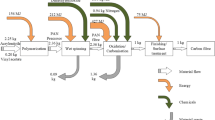Abstract
Aluminium alloys are a series of traditional materials applied in aerospace industry. Composite materials have been being used to replace some aluminium alloys in airframe structures. To select a cost-efficient material in aerospace design, a framework for systematic assessment of composites and aluminium is therefore suggested. Through evaluation of 3Ps which represent prices, properties and processing of material, life cycle assessment of aluminium and composite could be made. By comparison of and trade-off the listed baselines of 3Ps, an economic, rational, available and useful material can be logically selected.
Access this chapter
Tax calculation will be finalised at checkout
Purchases are for personal use only
Preview
Unable to display preview. Download preview PDF.
Similar content being viewed by others
6 References
Advisory Council for Aeronautics Research in Europe, Strategic Research Agenda, Vol.1, Vol.2, and Executive Summary, October 2004. URL: http://www.acare4europe.org/html/background.shtml [cited 12 September 2007].
The Science and Technology Sub-Group, Air Travel — Greener by Design, Mitigating the Environmental Impact of Aviation: Opportunities and Priorities, Royal Aeronautical Society, UK, July 2005.
Bailey, J.E., Charter 1: Origins of Composite Materials, in Composite Materials in Aircraft Structures (Ed. D.H. Middleton), Longman Scientific and Technical, Essex, UK, 1990, pp.1–8.
International Aluminium Institute, The Aluminium Industry’s Sustainable Development Report, 2007.
Niu, M.C.Y., Airframe Structural Design: Practical Design Information and Data on Aircraft Structures, Second Edition, Hong Kong Conmilit Press Ltd., 1999.
Peterson, G.P., Advanced Composites for Structures, Journal of Aircraft, Vol.3, No.5, 1966, pp.426–430.
Niu, M.C.Y., Composites Airframe Structures: Practical Design Information and Data, Hong Kong Conmilit Press Ltd., 1992.
Hinrichsen and Bautista, The Challenge of Reducing both Airframe Weight and Manufacturing Cost, Air and Space Europe, Vol.3, No.3/4, pp.119–121.
Middleton, D.H. (Ed.), Composite materials in Aircraft Structures, Longman Scientific and Technical, Essex, UK, 1990.
Vlot, A., and Gunnink, J.W. (Eds.), Fibre Metal Laminates: An Introduction, Kluwer Academic Publishers, Dordrecht, The Netherlands, 2001.
Baker, A., Dutton, S., and Kelly, D., Composite Materials for Aircraft Structures (2nd Edition), American Institute of Aeronautics and Astronautics, Virginia, USA, 2004.
Ashby, M.F., Materials Selection in Mechanical Design, Second Edition, Butterworth-Heinemann, Oxford, 1999.
U.S. Department of Transportation, Metallic Materials Properties Development and Standardization (MMPDS), Replacement Document for MIL-HDBK5, Scientific Report, DOT/FAA/AR-MMPDS-01, Federal Aviation Administration, January 2003.
Kalpakjian, S., and Schmid, S.R., Manufacturing Processes for Engineering Materials, Fourth Edition, Pearson Education International, N.J., USA, 2003.
Ehrlenspiel, K., Kiewert, A., and Lindemann, U., Cost-Efficient Design, Springer, Berlin, 2007.
F.C. Campbell, Manufacturing Technology for Aerospace Structural Materials, Elsevier, Amsterdam, the Netherlands, 2006.
U.S. Department of Defense, Military Handbooks-MIL-HDBK-17: Composite Materials Handbooks, 2002. Volume 1-Polymer Matrix Composites Guidelines for Characterization of Structural Materials; Volume 2-Polymer Matrix Composites Materials Properties; Volume 3-Polymer Matrix Composites Materials Usage, Design, and Analysis; Volume 4-Metal Matrix Composites; Volume 5. Ceramic matrix composites.
Tan, X., Wang, J., Xu, Y., Early, J., Raghunathan, S., Gore, D., and Doherty, J., Costing of Aluminium Process for Life Cycle, 46th AIAA Aerospace Sciences Meeting and Exhibit, Reno, Nevada, January 2008, AIAA-2008-1123.
Author information
Authors and Affiliations
Editor information
Editors and Affiliations
Rights and permissions
Copyright information
© 2008 Springer-Verlag London Limited
About this paper
Cite this paper
Tan, X. et al. (2008). Cost-Efficient Materials in Aerospace: Composite vs Aluminium. In: Curran, R., Chou, SY., Trappey, A. (eds) Collaborative Product and Service Life Cycle Management for a Sustainable World. Advanced Concurrent Engineering. Springer, London. https://doi.org/10.1007/978-1-84800-972-1_25
Download citation
DOI: https://doi.org/10.1007/978-1-84800-972-1_25
Publisher Name: Springer, London
Print ISBN: 978-1-84800-971-4
Online ISBN: 978-1-84800-972-1
eBook Packages: EngineeringEngineering (R0)




